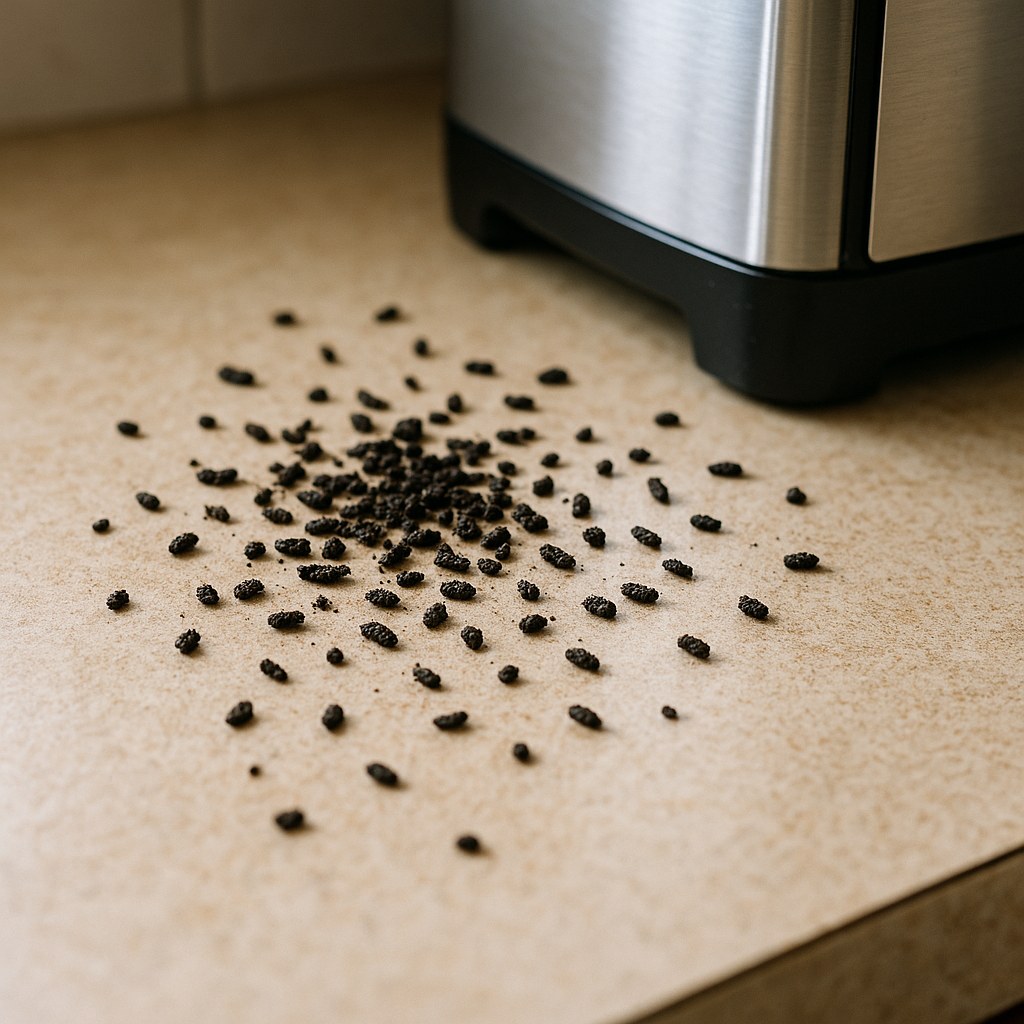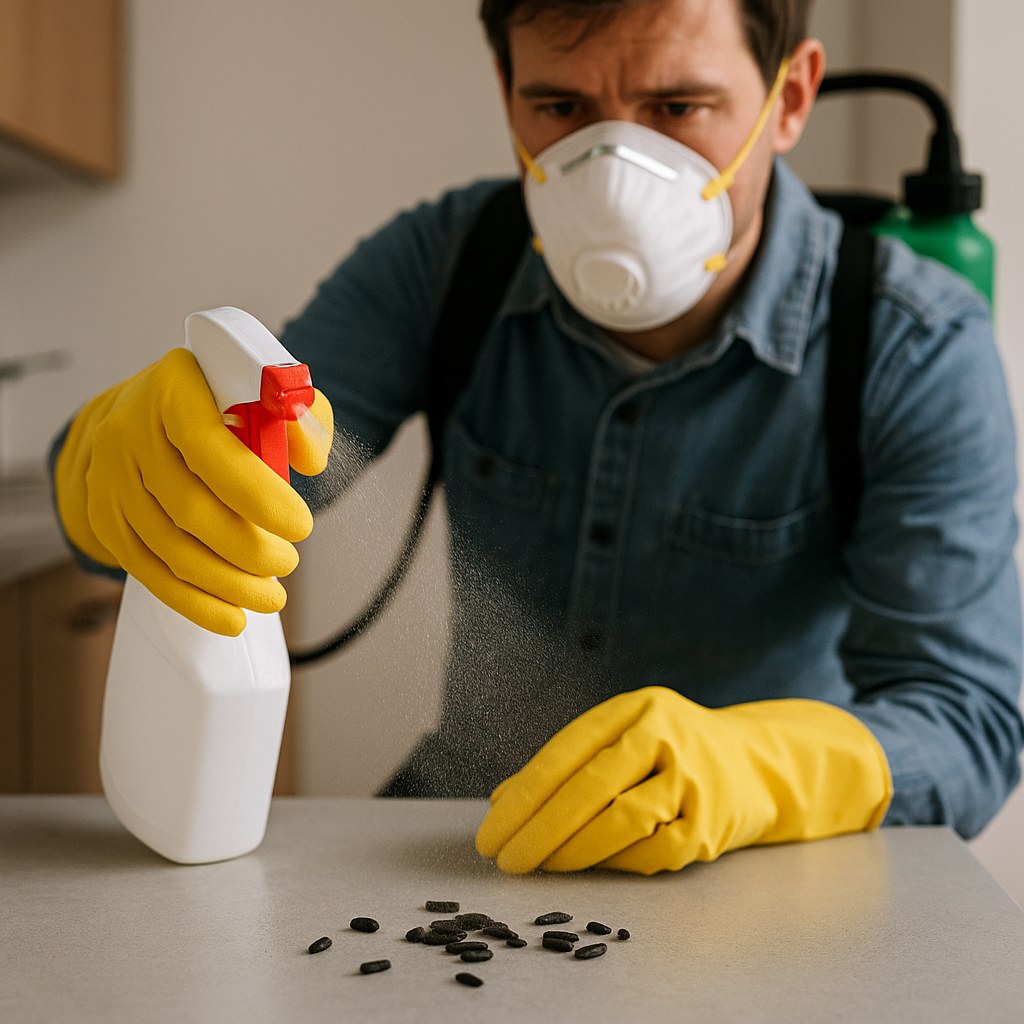How to Identify and Clean Up Droppings That Look Like Coffee Grounds
You reach for the toaster and notice something odd on the counter. A scattering of tiny, dark specks that look just like spilled coffee grounds or coarsely ground black pepper. But you haven't made coffee there, and the pepper mill is on the other side of the kitchen. That sinking feeling in your stomach is your intuition telling you this is something else entirely.
Discovering mysterious droppings in your home is unsettling, but you’re not alone. It’s a common issue homeowners face. The good news is that you’ve found a potential problem, and now you can take steps to solve it. Those "coffee grounds" are almost certainly pest droppings, and identifying the culprit is the first step toward reclaiming your space.
In this guide, we'll walk you through everything you need to know, just like we’re on the phone together. We’ll help you figure out what kind of pest you’re dealing with, show you how to clean up the mess safely, and give you a plan to make sure they don’t come back.

Identifying the Culprit: What Left These Droppings?
The size, shape, and location of droppings are the best clues for identifying your unwanted guest. While several pests can leave small droppings, the "coffee ground" description usually points to one primary suspect: cockroaches.
Cockroach Droppings
Cockroach droppings are the most likely match for what you're seeing. However, their appearance can vary slightly depending on the size and species of the cockroach.
- Small Cockroaches (like German Cockroaches): These are the most common home invaders. Their droppings are very small, black or dark brown, and look like specks of black pepper or coffee grounds. They may feel slightly greasy and leave behind small stains. You'll typically find them in areas where roaches congregate, like behind appliances, inside cabinets, in drawers, or near water sources in kitchens and bathrooms.
- Large Cockroaches (like American Cockroaches): Larger roaches produce larger droppings. These are cylindrical, dark, and often have ridges running down the sides. They can sometimes be mistaken for mouse droppings, but they are typically blunt at the ends, whereas mouse droppings are pointed.
How to Tell Them Apart from Mouse Droppings
It’s easy to confuse cockroach and mouse droppings at first glance, but there are key differences:
- Shape: Mouse droppings are spindle-shaped, larger than small roach droppings, and pointed at both ends. They look like small, dark grains of rice. Large roach droppings are more cylindrical and blunt.
- Texture: Mouse droppings may contain tiny hairs from the rodent's grooming. Cockroach droppings do not.
- Quantity: You will often find a larger quantity of mouse droppings in one spot, as mice excrete frequently as they travel.
If the droppings are pointed and about a quarter-inch long, you're likely dealing with mice. If they're smaller specks or blunt-ended cylinders, it's almost certainly cockroaches.
Why You Need to Act Fast: The Health Risks
Finding pest droppings isn't just an "ick" factor; it's a genuine health concern. According to the Environmental Protection Agency (EPA), cockroaches carry bacteria like Salmonella and E. coli, which can contaminate your food and surfaces.
Furthermore, their droppings, saliva, and shed body parts contain proteins that are powerful allergens. For many people, especially children and those with asthma, these allergens can trigger allergic reactions and severe asthma attacks. This is why cleaning them up safely and addressing the root cause is so important.
Step-by-Step Guide: How to Safely Clean and Assess the Situation
Before you grab a broom, stop! Sweeping or vacuuming dry droppings can send hazardous particles airborne, which you could then inhale. We’re going to do this the safe way.
Step 1: Gear Up and Observe
First things first, protect yourself. Before you touch anything, put on a pair of disposable gloves and consider wearing a face mask to be extra safe.
Now, take a closer look at the scene without touching the droppings directly. Ask yourself a few questions to assess the situation:
- Are they fresh or old? Fresh droppings will appear moist, dark, and almost shiny or tar-like. Old droppings will be dry, crumbly, and lighter in color. Fresh droppings mean an active, recent pest presence.
- How many are there? Is it just a few specks, or is it a large pile or scattered across a wide area? A small, isolated amount might be a one-time visitor, but large quantities suggest an established infestation.
- Where are they located? Are they indoors or outdoors? Near a potential entry point like a vent or crack? Under the sink or behind the fridge? The location is a huge clue.
Step 2: The Safe Indoor Cleanup Process
Whether the droppings are fresh or dried, the cleanup method is nearly identical and focuses on preventing airborne dust.
- Don't Sweep or Vacuum: This is the golden rule. We want to contain the mess, not spread it.
- Disinfect First: Lightly spray the droppings with a disinfectant or a 1:10 bleach-and-water solution. Let it soak for about 5 minutes. This wets the material, preventing dust, and starts killing any germs.
- Wipe, Don't Scrub: Use paper towels to gently wipe up the softened droppings. Place the soiled paper towels directly into a plastic trash bag.
- Disinfect Again: Once the droppings are removed, spray the entire surface area with your disinfectant again and wipe it clean with fresh paper towels.
- Dispose and Wash: Securely tie the plastic trash bag and dispose of it in an outdoor garbage bin. Remove your gloves and wash your hands thoroughly with soap and warm water for at least 20 seconds.

Step 3: Investigate for a Larger Infestation
You’ve cleaned the mess, but your work isn’t done. Now you need to determine if that was an isolated incident or a sign of a bigger problem. Grab a bright flashlight and become a detective.
Check the area around where you found the droppings and other common pest hotspots (kitchen, bathrooms, utility rooms). Look for these tell-tale signs:
- More Droppings: Check in dark, undisturbed places like behind the oven, under the sink, and in the back of cabinets.
- Gnaw Marks: Look for chewing marks on food packaging, wood baseboards, or wiring. This is more of a rodent sign but is good to check for.
- Nesting Materials: Pests will use whatever they can find to make a nest. Look for shredded paper, fabric, or insulation.
- Oily Rub Marks: As roaches and rodents travel along walls, they leave faint, greasy streaks from their bodies.
- A Musty Odor: A large cockroach infestation produces a distinct oily, musty smell. If you notice a persistent, unpleasant odor, it’s a strong indicator of a large population.
If you find evidence of any of these, you have an active infestation that needs more than just a simple cleanup.
Step 4: Fortify Your Home by Sealing Entry Points
Pests needed a way to get in. Your next mission is to find and seal their entryways. This is one of the most effective long-term solutions.
Sealing Indoor Gaps
Start inside. Look for small holes or gaps where pests could be hiding or traveling between walls. Common spots are around pipes under sinks, behind baseboards, and in corners of cabinets.
- For small cracks and holes, fill them with steel wool and seal over it with silicone caulk. Pests can’t chew through steel wool, and the caulk holds it in place.
- For larger gaps (over an inch), you may need to secure a piece of hardware cloth (a type of sturdy wire mesh) over the opening with wood screws.
Sealing Outdoor Entry Points
Now, take your inspection outside. Walk the perimeter of the house and look for any openings.
- Check for cracks in the foundation.
- Look for gaps around utility pipes, vents, and outdoor faucets.
- Ensure vent covers and window screens are intact and not damaged.
- Use the same method to seal these openings: steel wool and silicone caulk for smaller gaps, and hardware cloth for larger ones.
After sealing all potential entry points, monitor the area for one week. If no new droppings appear, your efforts have likely solved the problem!
When Is It Time to Call a Professional?
DIY pest control is effective for minor issues, but some battles are best left to the professionals. It’s time to call an exterminator if:
- You’ve sealed entry points, but new droppings continue to appear.
- You see multiple signs of a large infestation (e.g., a strong musty odor, seeing live roaches during the day).
- The problem feels too overwhelming to handle on your own.
A professional pest control visit can identify the exact species, locate nests, and use targeted treatments that are more effective and safer than many consumer-grade products. According to Forbes Home, an initial visit for a cockroach problem typically costs between $125 and $325. While it's an investment, it provides peace of mind and a faster, more permanent solution.

Take Control of Your Home
Finding pest droppings is never pleasant, but by following these steps, you can confidently handle the situation. Remember the process: safely identify and clean the droppings, inspect for further signs of an infestation, and seal up any entry points to prevent pests from returning.
Taking proactive steps to maintain your home is the key to preventing problems like this before they start.
For more expert advice on home maintenance, step-by-step repair guides, and access to a network of trusted professionals for the jobs you can't handle alone, download the Casa app today! We're here to help you keep your home safe, clean, and pest-free.

